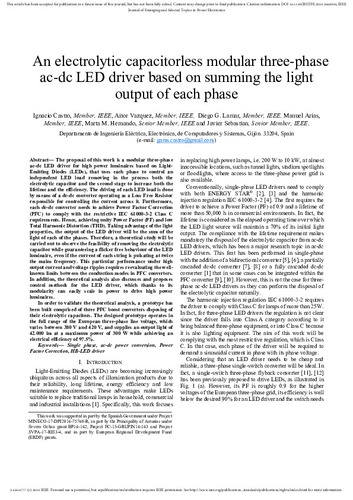An electrolytic capacitorless modular three-phase ac-dc LED driver based on summing the light output of each phase
Palabra(s) clave:
Single phase
Ac-dc power conversion
Power Factor Correction,
HB-LED driver
Fecha de publicación:
Editorial:
IEEE
Versión del editor:
Citación:
Resumen:
The proposal of this work is a modular three-phase ac-dc LED driver for high power luminaires based on Light- Emitting Diodes (LEDs), that uses each phase to control an independent LED load removing in the process both the electrolytic capacitor and the second stage to increase both the lifetime and the efficiency. The driving of each LED load is done by means of a dc-dc converter operating as a Loss Free Resistor responsible for controlling the current across it. Furthermore, each dc-dc converter needs to achieve Power Factor Correction (PFC) to comply with the restrictive IEC 61000-3-2 Class C requirements. Hence, achieving unity Power Factor (PF) and low Total Harmonic Distortion (THD). Taking advantage of the light properties, the output of the LED driver will be the sum of the light of each of the phases. Therefore, a theoretical study will be carried out to observe the feasibility of removing the electrolytic capacitor while guaranteeing a flicker free behaviour of the LED luminaire, even if the current of each string is pulsating at twice the mains frequency. This particular performance under high output current and voltage ripples requires reevaluating the wellknown limits between the conduction modes in PFC converters. In addition, the theoretical analysis also discusses and proposes control methods for the LED driver, which thanks to its modularity can easily scale in power to drive high power luminaires. In order to validate the theoretical analysis, a prototype has been built comprised of three PFC boost converters disposing of their electrolytic capacitors. The designed prototype operates in the full range of the European three-phase line voltage, which varies between 380 V and 420 V, and supplies an output light of 42.000 lm at a maximum power of 300 W while achieving an electrical efficiency of 97.5%
The proposal of this work is a modular three-phase ac-dc LED driver for high power luminaires based on Light- Emitting Diodes (LEDs), that uses each phase to control an independent LED load removing in the process both the electrolytic capacitor and the second stage to increase both the lifetime and the efficiency. The driving of each LED load is done by means of a dc-dc converter operating as a Loss Free Resistor responsible for controlling the current across it. Furthermore, each dc-dc converter needs to achieve Power Factor Correction (PFC) to comply with the restrictive IEC 61000-3-2 Class C requirements. Hence, achieving unity Power Factor (PF) and low Total Harmonic Distortion (THD). Taking advantage of the light properties, the output of the LED driver will be the sum of the light of each of the phases. Therefore, a theoretical study will be carried out to observe the feasibility of removing the electrolytic capacitor while guaranteeing a flicker free behaviour of the LED luminaire, even if the current of each string is pulsating at twice the mains frequency. This particular performance under high output current and voltage ripples requires reevaluating the wellknown limits between the conduction modes in PFC converters. In addition, the theoretical analysis also discusses and proposes control methods for the LED driver, which thanks to its modularity can easily scale in power to drive high power luminaires. In order to validate the theoretical analysis, a prototype has been built comprised of three PFC boost converters disposing of their electrolytic capacitors. The designed prototype operates in the full range of the European three-phase line voltage, which varies between 380 V and 420 V, and supplies an output light of 42.000 lm at a maximum power of 300 W while achieving an electrical efficiency of 97.5%
Patrocinado por:
Trabajo financiado por el Gobierno español, en el marco del Proyecto MINECO-17-DPI2016-75760-R; por el Principado de Asturias, Severo Ochoa BP14-142, Proyecto FC-15-GRUPIN14-143 y Proyecto SVPA-17-RIS3-4, y en parte por el Fondo Europeo de Desarrollo Regional(FEDER)
Colecciones
Ficheros en el ítem




